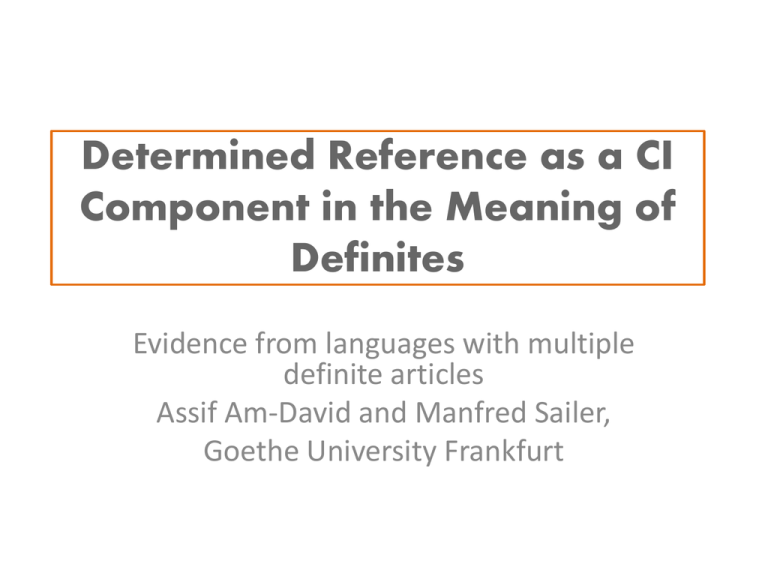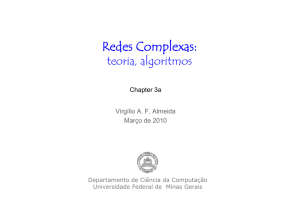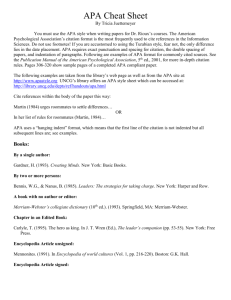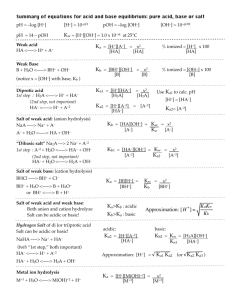Determined Reference as a CI Component in the Meaning of Definites
advertisement

Determined Reference as a CI Component in the Meaning of Definites Evidence from languages with multiple definite articles Assif Am-David and Manfred Sailer, Goethe University Frankfurt Determined Reference as a CI Component in the Meaning of Definites • • • • • • • • • Introduction Hierarchy of determined reference Why CIs? Typology of languages with multiple definite articles Hierarchy of determined reference in multiple definite articles Evidence for CI interpretation Fieldwork on Northern Frisian Referential covariation under quantification Summary Introduction Sioux (Lakota) (Siouan) (Rood & Taylor, 1996): • Articles : k?uN: anaphoric definite different from demonstratives: le’, he’, ka’ kiN: non-anaphoric definite waN-: indefinite (1) SˆuN’ka kiN he’l yuNke’. SˆuN’ka k?uN thalo’ kiN thebye’. Dog the there lie. Dog the.past meat the eat.up ‘The dog is lying there. The dog ate up the meat.’ Introduction • Schwarz (2013) distinguishes two definite articles: weak and strong. • Weak definite article marks uniqueness. • Strong definite article marks anaphoricity. Introduction Objectives: • Formally account for the distinction between definite articles – Using different types of inferences (presuppositions and CIs [=conventional implicatures]) • Propose a fine-grained model of determined reference to replace the dual distinction • Account for crosslinguistic variation in the domain of definite articles (including languages with three definite articles) Hierarchy of determined reference • Familiarity-identifiability based approaches (Maetzner, 1885; Christophersen, 1939; Jespersen, 1943; Strawson, 1950; Hawkins, 1978; Heim, 1982; Ariel, 1990; Gundel et al., 1993) • Uniqueness-maximality based approaches (Russell, 1905; Sharvy, 1980; Link, 1983; Landman, 1991) Hierarchy of determined reference • Combining both approaches: Donnellan (1966): Ambiguous (referential vs. attributive) Roberts (2003): Both together (uniquely identifiable) Hierarchy of determined reference • Schwarz (2013): Weak definites mark uniqueness, strong definites mark familiarity No apparent relation between the two. • Current attempt: combination of two different meaning components – Maximality presupposition A series of CIs – Degree of familiarity in the form of hierarchy of determined reference Hierarchy of determined reference • Maximality presupposition: ∃!x P(x) • Affirmative CIs: A. discourse-oldness (=anaphoricity) B. hearer-oldness Hierarchy of determined reference A. Discourse-oldness (+DO): The speaker believes the addressee knows there is a maximal element satisfying the definite description belonging to some subset of the universe of discourse. BELIEVE(I, (KNOW (you, ∃! 𝑥(𝑃𝑥 ˄ (x ∈ 𝑈𝐷))))) Hierarchy of determined reference • Good for: anaphorical definites (2) A student arrived. The student was helpless. • This allows extensionally non-referential anaphoras in opaque contexts with empty descriptions. (3) Everyone warned me of the witch in the cave. Yet, I was not afraid because I know the witch does not exist. Hierarchy of determined reference • For non-anaphorical definites the negative counterpart of the CI will be implied (-DO): BELIEVE(I, (KNOW (you, ¬∃! 𝑥(𝑃𝑥 ˄ (x ∈ 𝑈𝐷))))) Hierarchy of determined reference • B. Hearer-oldness (+HO): The speaker believes the addressee knows there is a maximal element satisfying the definite description. BELIEVE (I, (KNOW (you, ∃! 𝑥𝑃𝑥))) Hierarchy of determined reference • No empty set denotation. • Does not require acquaintance. • More closely related to referentiality in Strawson (1950) than Donnellan (1966) – No misdescriptions admitted. • Good for: uniques (4) The sun is rising. Hierarchy of determined reference • For non-hearer-old definites the negative counterpart of the CI will be implied (-HO): ¬BELIEVE(I, (KNOW (you, ∃! 𝑥𝑃𝑥))) Hierarchy of determined reference • The lack of both discourse-oldness and hearer-oldness is good for: • situational definites (5) Give me the hammer on the table. Hierarchy of determined reference • (non-anaphorical) attributive definites (Russellian quantificational account) (6) A: I do not know who the current king of Denmark is. B: In fact it is a queen – Margarethe II. No commitment to the existence of a maximal element satisfying the definite description. Hierarchy of determined reference Based on a distinction drawn by Schwarz(2013), bridging can evoke either +DO or -DO˄+HO depending on whether it is anaphoric or not. • +DO (strong definite): relational anaphoras Relation between antecedent and anaphora is semantically explicit. (7) I saw a book. Something about the cover kept intriguing me. Hierarchy of determined reference • -DO˄+HO (weak definite): non-relational anaphoras Relation between antecedent and anaphora is semantically implicit. (8) I bought a very nice painting. My wife said she particularly liked the green spots. Hierarchy of determined reference • Hierarchy: Determined reference Anaphoric Non-anaphoric Hearer-old Non-hearer-old Hierarchy of determined reference • The hierarchy does not cover all logical options, but depicts the possible marking patterns in language. • • Introduction Hierarchy of determined reference • Why CIs? • • • • • • Typology of languages with multiple definite articles Hierarchy of determined reference in multiple definite articles Evidence for CI interpretation Fieldwork on Northern Frisian Referential covariation under quantification Summary Why CIs? Indicative tests for discerning presuppositions and CIs (Levinson, 1983; Potts, 2005): (I) Presupposition failure with a logically unembedded presupposition trigger leads to the loss of truth value in the assertion (or falsity). Why CIs? (9) # I stopped playing the piano, but I have never played the piano. I played the piano (the presupposition lexically triggered by stopped) is either false (Russell, 1905) or undefined (Strawson, 1950), never true. Why CIs? Conversely, infelicitous flouting of a CI does not affect the truth value of the assertion, which can be true independently of the truth value of the CI. Why CIs? (10) "Alex met Probal, the president of the World Esperanto Association." -> No, that's not true, Alex did not meet Probal. -> #No, that's not true, Probal is not the president of the World Esperanto Association. Alex met Probal could be true or false regardless of the truth value of the identity between Probal and the description, which is a CI triggered by the apposition. Why CIs? (II) Presuppositions can project, but do not have to If the presupposition trigger is logically embedded, presuppositions can be cancelled (local accommodation). Example – polemic negation: (11) I did not stop playing the piano because I have never played the piano. Why CIs? Conversely, CIs must project and they can never be flouted (conjunctive addition) regardless of syntactic structure. (12) # It is not true he is smart but rich. Being smart has nothing to do with being rich. Here the CI is the contrary relation between smart and rich. Why CIs? Application to definites: (I) The cancellation of logically unembedded maximality leads to the loss of truth value in the assertion (Strawson, 1950) or its falsity (Russell, 1905). (13) # I saw the Harry Potter movie. In fact there are 8, of which I only saw the third. Here the assertion I saw the HP movie cannot be true. Why CIs? This does not happen with the infelicitous flouting of the CIs of determined reference. (14) # A studenti came by. The studentj asked me a question. In fact, it was not the student who came by. Truth value of assertion the studentj asked me a question can be true regardless of the infelicitous reference! (This can be stipulated if pointing is applied, for example.) Why CIs? • Second indicative test will be applied to definites later. • • Introduction Hierarchy of determined reference • Why CIs? • Typology of languages with multiple definite articles • • • • • Hierarchy of determined reference in multiple definite articles Evidence for CI interpretation Fieldwork on Northern Frisian Referential covariation under quantification Summary Typology of languages with multiple definite articles • Typology to provide morpho-syntactic categories. • Semantic distinction between strong, weak and super-weak definite articles to be explained below. Typology of languages with multiple definite articles (1) Strong and weak definite articles in a two definite articles system, phonologically unrelated: • Northern Frisian (Germanic, Indo-European) – strong: di/det, weak: a/at (Ebert, 1970), but see p.c. Faltings. • Sioux (Lakota) (Mississippi Valley, Siouan) – strong: k’uN, weak: kiN (Boas & Deloria, 1941; Rood & Taylor, 1996; van Vallin, 2012), both interpreted as topic marker in Ingham (2003). Typology of languages with multiple definite articles (2) Strong and weak definite articles in a three definite articles system: • Forest Enets (Samoyedic, Uralic) – strong: r, weak: da (Siegl, 2013; Gerland & Wratil, 2015) • Nganasan (Samoyedic, Uralic) – strong: rǝ, weak: zu (Schröder, 2006) • Mari (Uralic) – strong: yd, weak: ys (Schlachter, 1960; Klumpp, 2009) • Northern Frisian (Germanic, Indo-European) strong: di/det, weak: a, super-weak: a/at (p.c. Faltings) Typology of languages with multiple definite articles (3) Strong and weak definite articles, weak definite is a contracted strong definite: • German dialects (Germanic, Indo-European) – Alemannic German: strong: dε/di/das, weak: de/d/s (Studler , 2011), also Himmelmann (1996) for Franconian German. • Hausa (Chadic, Afro-Asiatic) – strong: ɗin, weak: n/r (Jaggar, 2001), strong one identical with demonstrative (Buba, 1997) Typology of languages with multiple definite articles (4) Strong and weak definite article, strong one identical with the demonstrative: • Malagasy (Malayo-Polynesian, Austronesian) – strong: ilay, weak: ny (Ferrand, 1903; Fugier, 1999) • Hausa (see (3)) Typology of languages with multiple definite articles (5) Only strong definite article: • Nenets (Samoyedic, Uralic) – strong: da/ta (Hajdu, 1963) • Hidatsa (Missouri River, Siouan) – strong: s (Matthews, 1965) • Fon (Fongbe) (Kwa, Niger-Congo) – strong: ɔ (Lefebvre & Brousseau, 2002) Typology of languages with multiple definite articles • Twi (Akan) (Kwa, Niger-Kongo) – strong: no (Addai Boadi, 2010) • Mupun (Mwaghavul) (Chadic, Afro-Asiatic) – strong: ɗi (Frajzynger, 1993) • Mangarayi (Mangaray-Maran) – strong: gi (Merlan, 1982) • Mauritian Creole (Bourbonnais Creoles) – strong: la, but extended (Wespel, 2008; Syea, 2013), intepreted as a specificity marker by Guillemin (2011) Typology of languages with multiple definite articles (6) Two definite articles, unrelated to the hierarchy of determined reference: • Scandinavian (Swedish, Danish, Norwegian) (Germanic, Indo-European) – • Distinction purely syntactic (cf. Dahl, 2004), depending on the presence of a modifier for example. • • Introduction Hierarchy of determined reference • • Why CIs? Typology of languages with multiple definite articles • Hierarchy of determined reference in multiple definite articles • • • • Evidence for CI interpretation Fieldwork on Northern Frisian Referential covariation under quantification Summary Hierarchy of determined reference in multiple definite articles Schwarz (2013) : • strong definite article – anaphoric definites • weak definite articles – non-anaphoric ones • Definite article can be phonologically empty. Hierarchy of determined reference in multiple definite articles In current model: • Languages with two definite articles: Strong definite article: +DO Weak definite article: -DO • Languages with three definite articles: Strong definite article: +DO Weak definite article: -DO,-HO Super-weak definite article: -DO,-HO Hierarchy of determined reference in multiple definite articles Semantic maps – contiguous covering (Haspelmath, 2000). Lexical example: tree German Baum Danish trae French arbre Spanish árbol wood (stuff) Holz trae bois madera firewood Holz trae bois leña small forest Wald skov forêt bosque large forest Wald skov forêt selva Hierarchy of determined reference in multiple definite articles Grammatical example: emphatic full grooming/ reflexive reflexive body motion anticausative potential passive passive |——————————| English himself |—————————————| Classical Latin se |—————————————————————| Late Latin se |————————————————————————|French se Italian si |—————————————————————————————| Surselvan (Romansch) se-|——————————————————————| Swedish –s |——————————————————| Hierarchy of determined reference in multiple definite articles Application of semantic maps to the typology of definite articles. 1) Uniqueness +HO˄-DO +DO Languages: Northern Firian, Forest Enets, Mari Hierarchy of determined reference in multiple definite articles 2) Uniqueness +HO˄-DO +DO Languages: Sioux, Alemannic German, Twi, Mangarayi 3) Uniqueness +HO˄-DO +DO Languages: English, Arabic, Q‘ekchi‘ Hierarchy of determined reference in multiple definite articles • Languages with the mapping (2) or (3) are vague (underspecified) as to the grammatical distinction between the semantic categories. • Attributive definites (-HO) appear not constitute a unit in the semantic map. For example, both strong and weak definites are allowed in Standard German in non-referential uses (own work). Hierarchy of determined reference in multiple definite articles • If a langugae has a phonologically realised indefinite article and no overt definite article a null definite article is assumed. • If the realm of the definite article is divided into two morpho-syntactic categories and one of them is covert, it will be the weak one. • If the realm of the definite article is divided into three morpo-syntactic categories and one of them is covert, it will be the super-weak one. Evidence for CI interpretation • • Introduction Hierarchy of determined reference • • • Why CIs? Typology of languages with multiple definite articles Hierarchy of determined reference in multiple definite articles • Evidence for CI interpretation • • • Fieldwork on Northern Frisian Referential covariation under quantification Summary Evidence for CI interpretation • Standard German: von dem/vom (from the) bei dem/beim (by the) zu dem/zum and zu der/zur (to the) in das/ins (to the) Evidence for CI interpretation • Both forms are very frequent. • Used to distinguish strong and weak definites (Schwarz, 2013) (15) Hans ging zum/zu dem Haus. Hans went to the (weak/strong) house. Evidence for CI interpretation • Hypothesis: Non-anaphoricity (-DO) is a CI, therefore, its flouting should be infelicitous. • Therefore: If the hypothesis is correct cataphoric definites with weak definite articles should be ungrammatical, even under the scope of negation. • Contrary: If non-anaphoricity is a presupposition it should be cancellable if under the scope of negation. Evidence for CI interpretation (16) Weil ich eh nicht zu dem/zum Fest gegangen wäre, hat mein Ex-Mann mich gar nicht erst zu seiner Hochzeit eingeladen. Because I wouldn‘t go to the(strong/weak) party anyway my ex-husband didn‘t invite me to his wedding in the first place. Evidence for CI interpretation (17) Weil ich nicht an dem/am Lauf teilgenommen habe, hat dieses Jahr jemand anderes den Berlinmarathon gewonnen. Because I didn‘t participate in the(strong/weak) run someone else won the Berlin Marathon this year. Evidence for CI interpretation (18) Weil ich nicht sonderlich an dem/am Möbelstück hänge, werde ich den Schrank beim nächsten Sperrmüll rausschmeißen. Because I‘m not particularly attached to the(strong/weak) piece of furniture, I will through away my cupboard with the next bulk trash. Evidence for CI interpretation • Plan to examine grammaticality judgments of native speakers of both contracted (weak) and full (strong) forms. • Future fieldwork on: Northern Frisian (Volkert Faltings, Ferring Stiftung) Alemannic German (Elvira Glaser, Zurich University) • • • • • • Introduction Hierarchy of determined reference Why CIs? Typology of languages with multiple definite articles Hierarchy of determined reference in multiple definite articles Evidence for CI interpretation • Fieldwork on Northern Frisian • • Referential covariation under quantification Summary Fieldwork on Northern Frisian Northern Frisian: • West-Germanic language, most closely related to the other Frisian languages (Eastern Frisian and Western Frisian) next to English • Formerly considered a dialect of Frisian, now consensually classified as a language (certainly not mutually intelligible, substantial grammatical variation) • Recognised minority language in Germany and EU Fieldwork on Northern Frisian • 10000-8000 speakers (Schleswig-Holstein, 2015) • All speakers fluent in standard German as well as Low German (highly diglossic environment) • Great influence from Low German and Danish • Potentially endangered, education available in Northern Frisian (school as well as university) • Major break between insular and mainland dialectal groups Fieldwork on Northern Frisian Fieldwork on Northern Frisian • According to p.c. Faltings: threefold system of definite articles • Strong article di/det diachronically derived from the demonstrative dihear/didiar. • Weak article is a reduced super-weak article a/at. • Ebert (1970) only mentions strong and superweak forms. • Indefinite article an. Fieldwork on Northern Frisian • • • • All data from Ferring-Amrum dialect No data on other dialects (Sölring, Mooring) Distinction missing in Eastern and Western Frisian Similar distinction present in Southern Juttish dialect of Danish (Ebert, 1970; Faltings, p.c.) – regional diffusion • Threefold distinction disappearing in FerringAmrum, strong form disappearing in younger speakers (p.c. Faltings) Fieldwork on Northern Frisian • Ferring Stiftung in Alkersum promotes research on Northern Frisian as well as school material and radio programmes • Native speakers of Northern Frisian from all ages available – focus on speakers older than 40 Fieldwork on Northern Frisian • First Phase: Study of the use of the three definite articles through • both judgments and elicitation • Second Phase: Judgments of cataphoric sentences with negation in order to determine status of inference Fieldwork on Northern Frisian Further plans pending financing: • Other dialects of Northern Frisian • Southern Juttish dialect of Danish • Language change in Northern Frisian (synchronic and diachronic) • • Introduction Hierarchy of determined reference • • • • • Why CIs? Typology of languages with multiple definite articles Hierarchy of determined reference in multiple definite articles Evidence for CI interpretation Fieldwork on Northern Frisian • Referential covariation under quantification • Summary Referential covariation under quantification • Problem: Referential covariation under quantification (19) Every student has a mentor and the mentor needs to meet her twice a year. • If referentiality is a CI how can the quantifier take scope over it hence preventing it from projecting? Referential covariation under quantification • Comparable case: (20) Jede Katze denkt, dass der Nachbarshund es zum Glück nicht merkt, wenn sie über den Zaun springt. Every cat thinks that the neighbour’s dog fortunately does not notice when it jumps over the fence. Referential covariation under quantification • Zum Glück (fortunately) is an evaluative adverb which brings about a CI: It is fortunate for x that P. • Conjunctive interpretation without covariation: CI: It is fortunate for x (x=the speaker) that P. Referential covariation under quantification • According to 20 readings judgments most natural reading: Every cat thinks: It is fortunate that P. • Hence, CI: For every x that is a cat, it is fortunate for x that P. Referential covariation under quantification • The universal quantifier takes scope over the CI. The variable in the CI covaries with the variable bound by the quantifier. • Conclusion: Covariation under quantification required independently of interpretation of referentiality in definites. • Probably, quantifiers can (should?) take scope over CIs. Conclusions • Uniqueness and anaphoricity follow distinct inference patterns • Two degrees of determined reference can account for more occurrences of definite article. • Account for languages with three definite articles. References • Addai Boadi, Laurence (2010). The Akan noun phrase. Accra: Black Mask. • Ariel, Mira (1990). Accessing noun phrases antecedents. Cambridge: Cambridge University Press. • Boas, Franz and Deloria, Ella Cara (1941/2011). Dakota grammar. Cincinnati: Whitefish. • Buba, Malami (1997). “The deictic particle DI-N in Hausa”. African languages and cultures. 10/1: 29-45. • Christophersen, Paul (1939). The articles. Copenhagen: Munksgaard. • Dahl, Östen (2004). “Definite articles in Scandinavian”. In: Kortmann, Bernd. (ed.). Dialectology meets typology. Berlin: Gruyter. • Donnellan, Keith (1966/1998). “Reference and definite descriptions”. In: Ostertag, Gary (ed.). Definite descriptions. pp. 173-193. Cambridge, Massachusetts: MIT Press. • Ebert, Karen H. (1970). Referenz, Sprechsituation und die bestimmten Artikel in einem nordfriesischen Dialekt (Fering). Kiel: Nordfriisk Instituut. References • • • • Ferrand, Gabriel(1903/2010). Grammaire malgache. Munich: Lincom. Frajzynger, Zygmunt (1993) A grammar of Mupun. Berlin: Reimer. Fugier, Huguette (1999). Sytaxe malgache. Louvain-la-neuve: Peeters. Gerland, Doris; Wratil, Melani (2015). Information structuring and definiteness marking in Forest Enets. Ms. • Guillemin, Diana (2011). The syntax and semantics of a determiner system. Amsterdam: Benjamins. • Gundel, Jeanette K.; Hedberg, Nancy; Zacharski, Ron (1993). “Cognitive status and the form of referring expressions in discourse”. Language 69(2): 274–307. References • Hajdu, Peter (1963). The Samoyed peoples and languages. Bloomington: Indiana University Press. • Haspelmath, Martin (2000). “The geometry of grammatical meaning: Semantic maps and cross-linguistic comparison”. In: Tomasello, Michael (ed.). The new psychology of language, vol. 2: Mahwah. New York: Erlbaum. • Hawkins, John A. (1978). Definiteness and indefiniteness. London: Croom Helm. • Heim, Irene R. (1982). The semantics of definite and indefinite noun phrases. Doctoral dissertation. University of Massachusetts. • Himmelmann, Nikolaus P. (1996). Demonstratives in Narrative Discourse. In: Fox, Barbara (ed.). Studies in Anaphora. pp. 203–252. Amsterdam: Benjamins. • Ingham, Bruce (2003). Lakota. Munich: Lincom. References • Jaggar, Philipp J. (2001). Hausa. Amsterdam: Benjamins. • Jespersen, Otto (1943). A modern English grammar on historical principles. Copenhagen: Munksgaard. • Klumpp, Gerson (2009). “Identifiability, givenness and zero-marked referential objects in Komi“ . In: Dufter, Andreas; Fleischer, Jürg; Seiler, Guido (eds.). Describing and Modeling Variation in Grammar. pp. 325– 359. Berlin: Gruyter. • Landman, Fred (1991). Structures for semantics. Dordrecht: Kluwer. • Lefebvre, Claire and Brousseau, Anne-Marie (2002). A grammar of Fongbe. Berlin: Gruyter References • • • • • • • Levinson, Stephen C. (1983). Pragmatics. Cambridge: Cambridge University Press. Link, Godehard (1983). “The logical analysis of plurals and mass terms: a lattice-theoretical approach”. In: Bäuerle, Rainer; Schwarze, Christoph; von Stechow, Arnim (eds.). Meaning, use and interpretation of language, Berlin: Gruyter. Maetzner, Eduard A. F. (1885). Englische Grammatik. Berlin: Weidmannsche Buchhandlung. Matthews, George H. (1965). Hidatsa syntax. London: Mouton. Merlan, Francesca (1982/1989). Mangarayi. London: Routeledge Potts, Christopher (2005). The logic of conventional implicatures. Oxford: Oxford University Press. Landesportal Schleswig-Holstein, http://www.schleswigholstein.de/DE/Fachinhalte/M/minderheiten/minderheiten_friesen.html, retrieved: 27.10.2015 References • Roberts, Craige (2003). “Uniqueness in definite noun phrases”. Linguistics and Philosophy 26:287–350. • Rood, David S.; Allan R. Taylor (1996). “Sketch of Lakhota”. In: Goddard, Ives (ed.). Hand- book of north American Indians. 17: 440–482. Washington: Smithsonian Institution. <lakxo- taiyapi.freecyberzone.com> retrieved: 23.6.2015. • Russell, Bertrand (1905/1998). “On denoting”. In: Ostertag, Gary (ed.). Definite descriptions. pp. 35-49. Cambridge, Massachusetts: MIT Press. • Schlachter, Wolfgang (1960). Studien zum Possessivsuffix des Syrjänischen. Akademischer Verlag: Berlin. • Schroeder, Christoph (2006). “Articles and article systems in some areas of Europe”. In: Bernini, Giuliano (ed.). Pragmatic organization of discourse in the languages of Europe. Berlin: Gruyter. • Schwarz, Florian (2013). “Two kinds of definites cross-linguistically”. Language and linguistics compass 7/10: 534-559. References • Sharvy, Richard (1980). “A More General Theory of Definite Descriptions”. The Philosophical Review 89: 607-23. • Siegl, Florian (2013). Materials on Forest Enets, an indiginous language of northern Siberia. Tartu: Tartu University Press. • Strawson, Peter F. (1950/1998). “On referring”. In: Ostertag, Gary (ed.). Definite descriptions. pp. 135-160. Cambridge, Massachusetts: MIT Press. • Studler, Rebekka (2011): Artikelparadigmen. Doctoral dissertation. University of Zurich. • Syea, Anand (2013). The syntax of Mauritian Creole. London: Bloomsbury. • van Vallin Jr., Robert D. (2012). Definiteness in Lakhota. Ms. • Wespel, Johannes (2008). Descriptions and their domains. Doctoral dissertation. University of Stuttgart.


